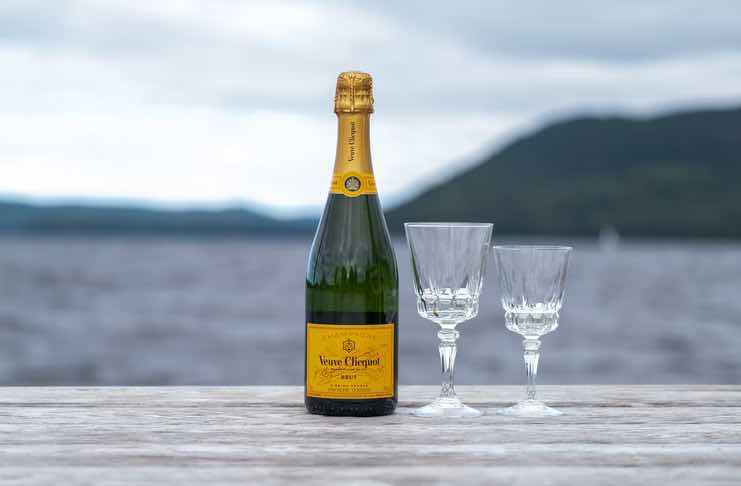Curious about how Champagne is made? Where it’s made and why it became so popular? You’ve reached the right place. Obviously, we all know Champagne as a lavish name for one of the tastiest sparkling wines in the world. Most of us also know that it’s a French wine, but did you know that by EU law – only sparkling wines made in a very distinct way and only in a tiny region in the north of France can carry the fancy name of “Champagne”? On top of that, Champagne has several special attributes that make it taste absolutely different from other sparkling wines made elsewhere.
About The Region of Champagne
You may not be aware, but there’s a province called Champagne, 100 miles east of Paris, in the northeast of France, where this fancy sparkling wine is produced. Why is the region so perfect for sparkling wines?
Well, Champagne’s high latitude and mean annual temperature (the average of the maximum and minimum temperature of a year) of 50 °F (10 °C) forge a challenging environment for grapes to ripen, and therefore produce high levels of acidity – creating the ideal grapes for sparkling wines. The dominant grapes grown in Champagne include Pinot noir, Pinot Meunier, and the famous Chardonnay.
According to the latest statistics, there are around 16,200 wine-growers and 320 Champagne houses in Champagne. The yearly harvest in 2020 produced 231 Million wine bottles worth 4.2 billion EURO. The top export markets of Champagne are the UK and US, followed by Japan, Germany and other EU countries, as well as Australia.
How Is Champagne Made in Champagne?
The production process of Champagne is quite complex and long. Most Champagne types take at least 15 months of various production processes, while the preparation of “exceptional” Champagnes (in French called millésime) can last more than 3 years.
The Harvest and 1st Fermentation
In the Champagne region, no machines are allowed to pick the grapes, so these are hand-picked from August to October. Why is that? The reason is very simple and French: So only the ripest and very best grapes are carefully picked for the wine production.
After that, the juice made from the grapes is placed into a tank, and the first fermentation starts. This process usually deploys special rubber hoses with advanced polymer coating that provide exceptional benefits over old PVC hoses.
The outcome of this first fermentation, where all the natural sugar is distilled out of the juice, is a very acidic wine.
The Assemblage & 2nd Fermentation
This exciting phase is regarded as the most important part of “How is Champagne Made”. What does Assemblage mean? Well, it’s practically the art of blending and mixing of different non-vintage fermented base wines in order to create the unique taste and quality of a new Champagne.
Champagne growers can use over 70 various types of fermented grapes to make their special blend of Champagne. The creative assemblage phase begins approximately 5 months after the stage of harvesting.
An experienced Champagne maker will smell and taste the base wine to know what exact flavors need to be blended for the 2nd fermentation phase.
This is another crucial stage in making Champagne. In this 2nd fermentation, the wine bottles are turned upside down, letting the special blend created during the Assemblage to mix and age together with carbon dioxide, for anywhere between 15 to 30 months. During this process, the Champagne maker adds a certain amount of sugar (every winemaker adds as much as he feels right) in order to balance the acidity level.
The Aging, Riddling, and Disgorging
After the 2nd fermentation process is complete, the Champagne is placed in a cool cellar to age for a few more years. This aging process allows the yeast cells to open up and dribble, yielding even more robust flavors to the new Champagne.
Following the aging phase, the bottles are put upside down in a special 75-degree angle, in order to get rid of the dead yeast cells. This procedure is called Riddling, and it uses a machine called Gyropalette whose moving parts are treated with a polymer coating to reduce friction, noise and corrosion.
The final phase in the making of Champagne is the Disgorging step. This is when the bottles are still upside down, while the necks are frozen in an ice-salt bath. This forms a wedge of frozen wine that holds the dead yeast cells. Then, the bottle cap is removed while the pressure of the carbon dioxide compels the wedge of frozen wine out.
The Dosage and Corking of Champagne
In the Dosage stage, the Champagne maker adds a certain mixture of white wine, brandy and sugar in order to adjust the level of sweetness of the Champagne. This phase will determine if the Champagne will become a Dry, Extra Dry, Semi-Dry, Brut Nature, Extra Brut, or Doux.
After this, the Champagne bottle is corked and wired, ready to be shipped away.
Curious to see the process of how Champagne is made? Watch this video:
Conclusion
The process of making Champagne is a complex one, and it takes much longer than most other types of wines. However, at the end – you get a unique sparkling wine that can only be made in one small region of the World. So the next time you get your bottle of Champagne, take a moment to appreciate the long way it’s made to reach your table.

